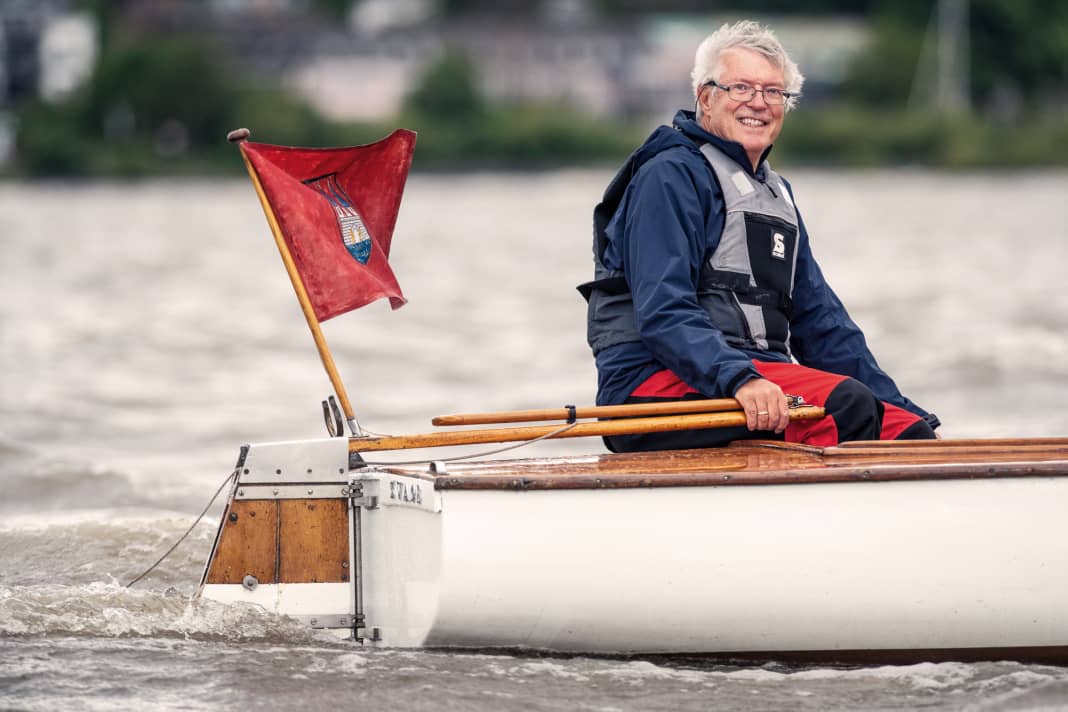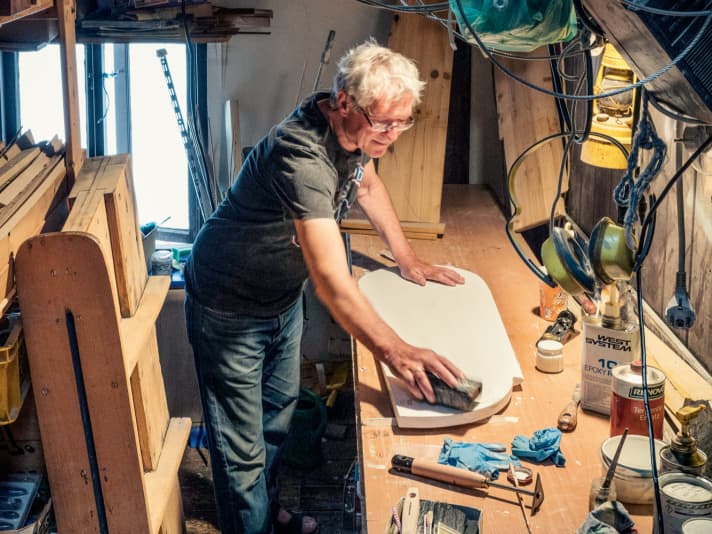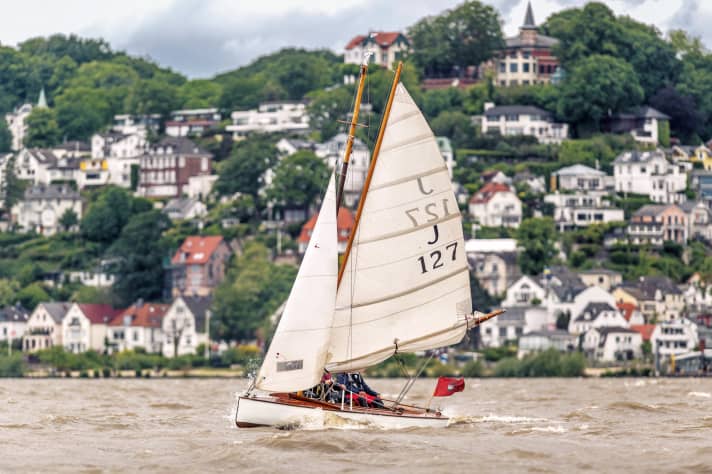





Manfred Jacob is fascinated by boats that are in a "miserable state". As early as 1976, when he, just 20, rescued a 30 dinghy cruiser from De Dood together with a friend. After a storm surge, it had a large hole in the hull. Jacob buys it for 2,000 Deutschmarks. "Wooden boats didn't count for anything back then," he says looking back and recounts how they painted the boat white and stuck an anti-nuclear sticker on it, because Jacob was demonstrating in Brokdorf at the time - "non-violently", as he emphasises.
It is the start of a life with and for the classic dinghies - especially the 22 square metre racing dinghies, better known as J dinghies. Manfred Jacob has been their class president for more than 20 years. The Hamburg native has been responsible for the dinghy classes in the Circle of Friends of Classic Yachts since it was founded. And even today, at retirement age, he still sails three dinghies that he has restored himself.
The name Manfred Jacob is inextricably linked with the J dinghy
In 1976, the friends christened the Jolli "Elk" and the six of them sailed to Helgoland. When it was sold, Jacob was able to use the proceeds to finance a six-month backpacking trip through Central and South America. He had already discovered his passion for travelling as a 17-year-old and, after giving his pirate a new deck made of mahogany plywood, sailed it on the Elbe and as far as Denmark.
"That was freedom," says Jacob. It was revealed to him at an early age. As a young boy, he sailed with his father on a dinghy across Lake Selent in Schleswig-Holstein. And when he was twelve, he and his brother were given a clinker-built dinghy made of oak. With a Mickey Mouse as a sail mark in the mainsail.
A 30 dinghy cruiser is still his dream today, says Manfred Jacob. This is a little confusing, as his name has been inextricably linked with the J dinghy that he has been sailing since 1979 for decades.
His wife doesn't like sailing
Nevertheless, in 1992 he bought and restored an old GDR dinghy cruiser for the family "on the side". But his happiness was short-lived. "Sailing doesn't suit me at all," says Jacob's wife Heilwig. If the wind is stronger than 3 Beaufort, she gets scared. Sailing basically means either stress or boredom for her. So the boat is soon sold again - painfully. The dream is over.
"This is probably the worst injury I've ever inflicted on you," says Heilwig Jacob to her husband. The painter studied at the University of Fine Arts in Hamburg. She has her studio under the roof of the old flat they share in Hamburg's trendy Ottensen neighbourhood. The list of her exhibitions is long.
Manfred Jacob, who still wears his "Pink Floyd" shirt from the legendary album "The Dark Side of the Moon", has set up his small workshop right next to her studio, where he works on boat parts. The two have been living together since 1978.
A miserable condition of the dinghy does not deter Manfred Jacob
When Jacob sold his dinghy cruiser in the mid-nineties, he was already firmly rooted in the J dinghy community, where the term I dinghy is used, although it is spelt with a J after the sailing symbol. He discovered his first own J dinghy in 1979 behind the North Sea dyke in Friedrichskoog. At the time, the boat was in a "pitiful state".
Most of it is missing: rig, centreboard, deck, transom, floorboards. But once again, the enthusiast is not deterred by this wretched state, but attracted by it, and he buys the wreck for 500 Deutschmarks. The story that the "Sir Willi von Ottensen", built in 1924, once belonged to his father is perhaps just a legend. Nevertheless, he saved the ship. Within just one year, everything was repaired and Jacob sailed it through the Dutch Wadden Sea.
At some point, Jacob knew every J dinghy still in existence, and when the opportunity arose in 1991, he bought the "Fram" designed by Reinhard Drewitz, a sister ship to Manfred Curry's "Mephisto". The study of the boat from 1924 leads into the history of the class.
The J dinghy was created in 1909 as an inexpensive training boat
Its origins date back to 1909, when the German Sailing Association was looking for a cheap training boat for young sailors and created the first ever national dinghy class, the J dinghy. The main requirement was that the length and width had to add up to 7.80 metres, but the boat had to be at least 1.70 metres wide. The rigging was completely optional, but the steep gaff was superior.
As a genuine construction class, the J dinghy developed rapidly. "It soon became a high-tech machine," says Manfred Jacob, who has been class president for over 20 years. "It was a dream boat of its time." Prominent sailors such as the 1938 world champion in the Star boat, Walter von Hütschler, and the 1936 Olympic champion in the Star boat, Peter Bischoff, sailed J dinghies.
The J dinghy is the faithful wife, the Z dinghy the racy, modern woman
This also challenged the designers. Among the cracks were well-known names such as Carl Martens, Reinhard Drewitz and Manfred Curry. The latter compared the J dinghy somewhat derisively to a "reliable, faithful housewife", while the competing Z dinghy - which was much slimmer - was for him "a modern, racy, lively woman", which, according to Curry, was somewhat more expensive. The J dinghy also glided, but not at this speed and only in stronger winds: "You undeniably have the feeling that there is a bucket somewhere in the water holding the boat back," wrote Curry.
The J dinghy places high demands on the sailors
However, with a sail area of 22 square metres, the over-rigged J dinghy has seven square metres more canvas than the 15-square-metre hiking dinghy, better known as the H dinghy - with almost identical dimensions. If the Elbe H dinghy is a "plough horse", the J dinghy is a "thoroughbred", someone once said. "It places the highest demands on the crew. But that is precisely what appeals to the racing sailor, he loves the high school of dinghy sailing," was a hymn to the J dinghy from 1941.
When Manfred Jacob took over the "Fram" in 1991, he once again succumbed to the allure of a miserable condition. He invested three years, 1,000 hours of work and 15,000 Deutschmarks in the boat. 30 ribs had to be replaced, thousands of copper rivets had to be hammered in, the plank seams had to be milled out and lined before the hull could be sealed again after weeks of sanding. In addition to the deck, he also completely replaced the rig. The graduate physicist and now recently retired programmer has written his own programme for calculating gaff sails.
The "Fram" is lovingly cared for even after its restoration. When the mast needs to be shaffed, Jacob takes it over the balcony to his old flat on the first floor. During the Christmas period, the spar reaches into the living room, but the workshop under the roof is simply too small for this.

Manfred Jacob knows the history of 1,000 dinghies
Manfred Jacob has already managed speeds of more than 18 knots with his speed-trimmed "Fram". At home, a wooden model of the J-dinghy "Aera II" with an extra-long blue keel always reminds the enthusiastic sailor of adventures like this. Manfred Curry won the Sailing House Prize in Berlin with the original in 1938. At the time, this was regarded as the unofficial German championship for all dinghy sailors.
Manfred Jacob has already researched the history of a good 1,000 classic dinghies and documented it in an archive that is "constantly being built up". Around 100 of the J dinghies alone still exist and are listed in the yacht register of the Freundeskreis Klassische Yachten. Manfred Jacob was involved in its foundation in 1994. Two years later, he wrote a treatise for the association on the "Origin and Development of the Association Dinghy Classes in Germany". To this day, Manfred Jacob is the contact person at the circle of friends for all questions relating to dinghy classes. He also dedicated a detailed commemorative publication to the J dinghy on its 90th birthday in 1999.
The "Woge" is also saved by Manfred Jacob
When the oldest boat in the fleet is to be scrapped in 1996, it is Manfred Jacob who saves it. As was to be expected, he was struck by the "wretched condition". Planks, frames and floor beams are loose and rotten, the keel beam is broken. The polyester shroud has come loose from the boat. The ship, built by Willy von Hacht in 1922, is to be cremated. So Manfred Jacob buys it for 1,000 Deutschmarks - because it comes with a trailer. His idea: "I wanted to sail her as a daysailer on the Elbe, together with my son Marek."
He was just five at the time. A photo from the following year shows him lying in the mainsail of the "Woge" in his oilskin and lifejacket. "We sailed for ten days on the Müritz, through the canals into Lake Plau and back," says his father. "That was pure adventure." If he has to hoist or reef the sails, the child steers. At night, they slept under the tarpaulin on the floorboards and cooked as if they were camping.
"As soon as the 'Woge' was in one piece, he was already sailing with Marek," says Heilwig Jacob, praising the "great father-son relationship". The two later sailed together on the Schlei, the Frisian Lakes, the Havel and the Bodden waters, as well as several times in Finland.

Manfred Jacob never wanted a large yacht
In the summer of 2012, the pair even travelled 400 kilometres down the Elbe on the "Woge", from Lovosice in the Czech Republic to Magdeburg. "You don't need a big yacht to experience great things," writes YACHT. And Manfred Jacob is indeed someone who has never needed a big yacht.
For the 100th birthday of his "Woge" last year, the now 67-year-old repainted the hull, which is made of gabon and oak, and attached a shiny golden plaque to the bow. He then invited guests to a ceremony with a laudatory speech in the Mühlenberg marina on the Elbe.
The 'Woge' is immortal"
"The 'Woge' is immortal," says Manfred Jacob today. "The new awareness of yacht history seems to have come at just the right time for many dinghies," he wrote back in 1996: "It could help to save the last remaining boats today."
In any case, the "Woge" is still underway: when YACHT classic is on board, the wind is sweeping across the Elbe at 6 Beaufort. Only very few sailors dare to go out on this day, where you can look out over the backdrop of the noble Hamburg suburb of Blankenese. Even in the third reef and with a pirate's jib, the J dinghy is still racing wildly across the Elbe, which splashes into the cockpit at the cross with every wave, where it gurgles out again. For a racing dinghy, the "Woge" is "good-natured", says Jacob. And now "rather slow". She is supposed to be a daysailer, so she can weigh 80 kilograms more than the "Fram".
In 1937, she won her most important prize against 45 competitors - the "Blue Ribbon of the Lower Elbe", a highly prestigious regatta. Back then, it was a night race of 60 nautical miles that ended in Cuxhaven after just under eleven hours. So the dinghy is definitely suitable for long distances. Over the years, Manfred Jacob has not only renewed her floor cradles and mast base, but also the centreboard box of his "Woge" and straightened the stem. So that it looks like it used to. "I make every effort to make the 'Woge' look classic," says Jacob.
A few modernisations are permitted
Nevertheless, he has allowed himself a few modernisations - he is not someone who wants to preserve the condition in which the "Woge" was once delivered at all costs. The breakwater has therefore been shortened, so there are outrigger straps and a furling jib with a plastic furler, which would be banned on other classic boats. Instead, the on-board pharmacy is wrapped in wood in true style, and there are no on-board electronics on the "Woge", nor is there an outboard motor. Instead, it is rigged.
But always just going sailing: That's not for Manfred Jacob either. Even though he recently bought a 70-year-old Elbe H dinghy. Because it is a little less complicated than the J dinghies and because he lacked a boat for the Wednesday regattas on the Alster, where the dinghy is moored.
One day after his 60th birthday, he gets on his new trekking bike in Hamburg and rides it to Budapest, a good 1,500 kilometres. Israel is his destination, but the war in Syria prevents him from travelling there. So he cycles on, in stages of four weeks each, from Budapest to Istanbul, from Istanbul to Cyprus and from there across the Balkans. And, no, it's not an e-bike.

